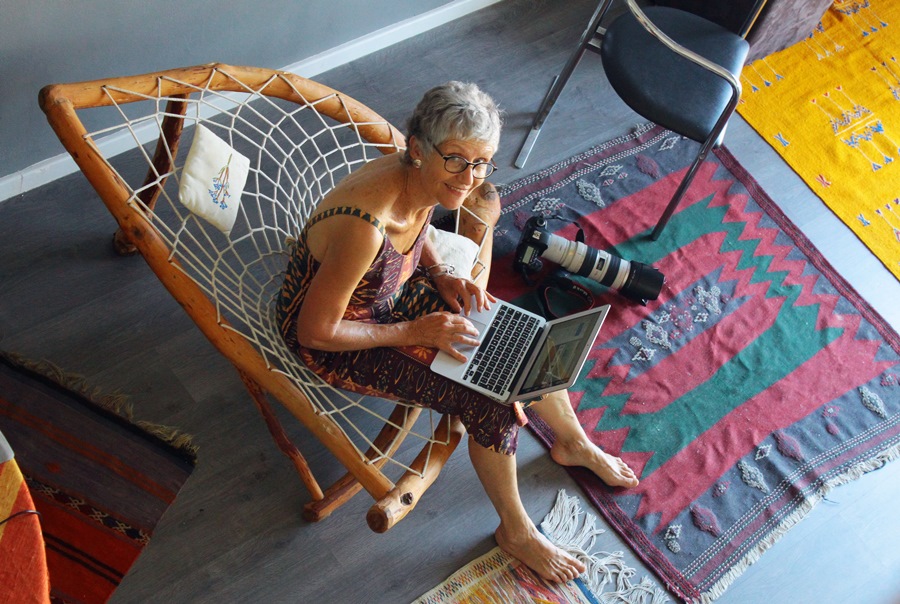I'd like to begin by asking you some questions about your photo-essay Still Life in Motion. What has been the most unexpected outcome of the project for you?
The fact that finally, after three years I got it all together; images and texts provided by participants in the project, published in book form, printed beautifully by Hansa printers in cape town.
How difficult was it to overcome any challenges involved with capturing moving figures?
Very. It was a question of trial and error, and many, many discarded images before finding the one in a set that possessed the multiple head and/or ghost figure that, in my view, suggested the other intangible presence I was seeking.
Your statement "Reality seems to splinter in my viewfinder, revealing, more and more, an illusion." Would you mind elaborating on the illusion?
Literally I meant that forms/figures/faces that seem whole and therefore perfect in so called real life, became distorted with broken outlines in my images caused by slow camera shutter speed. These ‘splintered’ shapes in a sense represent the scarred selves we stow away behind a surface of perfection. The distorted, imperfect shapes reveal for me, the truth of reality more convincingly than the perfect shapes we so often mistake for the only ‘real’ world.
Has the way you feel about your own body and age changed because of Still Life in Motion?
I have not had an issue with the destruction in my own body by age, but the process perhaps contributed to my growing acceptance of scattered thoughts and forgetfulness.
The subjects in your photos enjoy anonymity in that they're not easily - if at all - recognizable. Do you find or think that this allows them more freedom to move their bodies and to show more of themselves?
It was exactly the anonymity through distortion that persuaded most models to participate in my project! In their own words they affirmed the greater freedom their own distorted image gave them to express themselves freely without being self conscious about wrinkles and other warts of age.
How difficult did you find it to decide on the material - archival paper, silk or metal - on which to produce each of your images?
Not difficult because I like experimenting and don’t mind wasting some money on printing on different surfaces and then deciding whether I liked the end result or not. I also allow the expert technical advice from master printers to be a guide line.
People can see your book 'STILL/LIFE IN MOTION – a portrait of time passing' at our gallery at 50 Buitenkant Street. Where else can they find it?
At exposure gallery at the biscuit mill in Woodstock, the Mogalakwena gallery where the book was launched in September 2015 with a solo exhibition of images from the book, and at my studio. The book is available in hard cover, a4-size, limited edition.
Do you find that your skills and experience in journalism, academic writing, fiction writing and art reviewing impacts or influences how you approach your photography?
On some unconscious level I would imagine, yes. In all five cases I generally start with something that touches my heart, more than my mind and approach a subject/project intuitively. Initially there is only a vague sense of direction or a core idea, which grows and changes constantly and lands me in chaos. Re-writing, re-photographing re-processing gradually unlocks meanings or symbols, beneath what seems to be a kind of surface. The main concern in all these areas is for me to discover something new behind the obvious on the surface.
What do you feel have you gained as an artist as you grow older?
Diminished fear that I will crash my computer when I push wrong buttons during editing photos. More confidence in using error as a creative tool.
What do you think every photographic artist should have as part of their creative arsenal?
Computer and editing tools to tease out all possibilities present in a digital negative.
Which work is the first artwork that comes to mind when I ask you your favourite artwork?
At this moment, Picasso’s Guernica.
What should people know about your photography that they can’t tell from looking at it?
I have no idea! A successful work that is open ended enough to tickle the viewer’s interest, I think, is one that reveals bits of itself over time.
Tell us about your studio. Do you have your own darkroom? Where is your studio or work space? How big/small, cluttered/neat? Do you work onsite more than in the studio?
My studio is the small apartment and balcony on the fifth floor of a building in the Mother City, where I live with my back to the Lion and my view on the Table with its ever changing cloth. A table with computer, camera sometimes mounted to catch the mist when it turns Strand Street and the mountain into a place of fantasy. I prefer reasonably tidy surroundings.
Do you work with or without music?
Definitely with music. The radio station, Fine Music Radio, has changed my life style when I moved to Cape Town. In Johannesburg I usually packed my things and went to work and wrote in a mall. When I arrived here, and when wanting to pack my things to go out I would hear a song on FMR that formed part of an hour-long programme and I would say to myself that I would just sit and listen and work for a little while. And then I would end up spending my entire morning here, and get so much work done in the comfort of my own place. Only when I get hungry would I then go out and get something from one of the many nice food places in the area. So I work here, with FMR on the radio, or music on the internet. Because of Fine Music Radio my working lifestyle has changed completely.
What do you collect?
Stones with interesting shapes or textures
What clothing item couldn’t you live without?
My walking shoes/boots
Do you have any advice for aspiring artists and fine art photographers?
See every day from light through dark back to light as a magical adventure
 Bettie Coetzee-Lambrecht in the lower floor of her studio
Bettie Coetzee-Lambrecht in the lower floor of her studio

